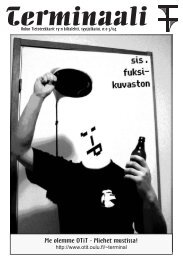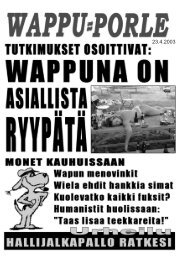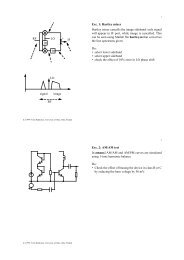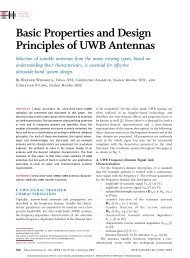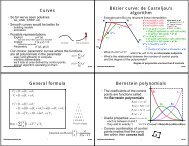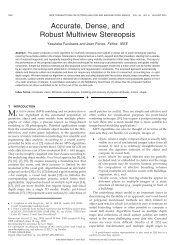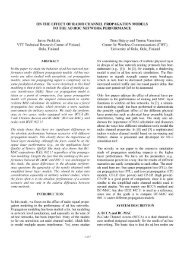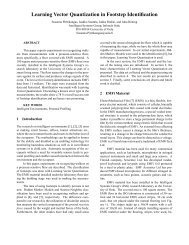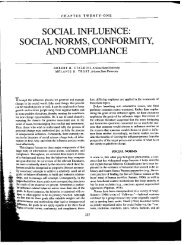ORIGINATOR OF TELETRAFFIC THEORY - Oulu
ORIGINATOR OF TELETRAFFIC THEORY - Oulu
ORIGINATOR OF TELETRAFFIC THEORY - Oulu
You also want an ePaper? Increase the reach of your titles
YUMPU automatically turns print PDFs into web optimized ePapers that Google loves.
SCANNING OUR PAST<br />
To the Memory of Agner K. Erlang<br />
<strong>ORIGINATOR</strong> <strong>OF</strong><br />
<strong>TELETRAFFIC</strong> <strong>THEORY</strong><br />
This article is dedicated<br />
to the memory of the<br />
Danish scientist Agner<br />
Krarup Erlang, who<br />
during his professional lifetime made<br />
numerous pioneering and fundamental<br />
contributions in the area of teletraffic<br />
theory development. Going<br />
back to the history, it is interesting<br />
to remember some significant dates.<br />
More then 60 years ago, in October<br />
1946, CCIF (CCITT and ITU forerunner)<br />
decided to adopt 1 Erlang as the<br />
international unit for telephone traffic.<br />
Also, more than nine decades ago<br />
(1917), one of the most significant<br />
work applying telephone traffic theory<br />
for the derivation of the loss<br />
formula, as well as the delay formula,<br />
was published by Erlang. Just over a<br />
century has passed since Erlang published<br />
(in 1909) his first work, a<br />
landmark contribution dealing with<br />
the theory of the probability application<br />
in resolving problems connected<br />
to telephone traffic. In that way,<br />
Poisson probability distribution was<br />
proved for telephone calls arrival and<br />
traffic.<br />
I. THELIFE<strong>OF</strong><br />
A. K. ERLANG<br />
Agner Krarup Erlang was born more<br />
than 130 years ago (1 January 1878)<br />
in Lonborg, Denmark. He was the<br />
son of a schoolmaster, and a descendant<br />
of the prominent mathematician<br />
Thomas Fincke on his mother’s side.<br />
Agner spent his early school days at<br />
his father’s schoolhouse together<br />
Digital Object Identifier: 10.1109/JPROC.2009.2035167<br />
0018-9219/$26.00 Ó2009 IEEE<br />
Fig. 1. A. K. Erlang at the age of 15.<br />
This Scanning Our Past<br />
article from Europe takes a<br />
look at the professional<br />
accomplishments of<br />
Danish scientist<br />
Agner Krarup Erlang,<br />
who made pioneering<br />
contributions in teletraffic<br />
theory development.<br />
with his mother, brother, and two<br />
sisters [1].<br />
At age 14, A. K. Erlang passed<br />
the Preliminary Examination of the<br />
University of Copenhagen with distinction,<br />
after receiving dispensation<br />
to take it because he was younger than<br />
the usual minimum age (Fig. 1). The<br />
special entrance permission was<br />
granted. After that, Erlang returned<br />
to Lonborg and become assistant<br />
teacher at his father’s school for<br />
two years. He taught alongside his<br />
father. When he reached the age<br />
of 16, his father thought that he<br />
ought to continue his studies. The<br />
Frederiksborg Grammar-School had<br />
two scholarships, and A. K. Erlang<br />
attained one of these. He studied<br />
mathematics and natural sciences at<br />
the University of Copenhagen. His<br />
mathematical education was greatly<br />
influencedbyProf.H.G.Zeuthen’s<br />
and Prof. C. Juel’s lectures. All his life<br />
he maintained and cultivated his<br />
interest in geometrical problems.<br />
He finished his university studies<br />
in January 1901 by receiving the<br />
degree of candidatus magisterii with<br />
mathematics as principal subject and<br />
astronomy, physics, and chemistry<br />
as secondary subjects. For some years<br />
Erlang worked as a teacher at various<br />
schools. He proved to be in possession<br />
of excellent pedagogical qualities,<br />
even though his natural predilection<br />
was for scientific research rather<br />
than for teaching. He managed to<br />
find time for attempting the mathematical<br />
prize essay of the University<br />
for 1902–1903 on Huygens’ solutions<br />
of infinitesimal problems, for which<br />
attempt he was rewarded with an<br />
Baccessit[ in 1904. He had then<br />
Vol. 98, No. 1, January 2010 | PROCEEDINGS <strong>OF</strong> THE IEEE 123<br />
Authorized licensed use limited to: <strong>Oulu</strong> University. Downloaded on January 14, 2010 at 08:25 from IEEE Xplore. Restrictions apply.
Scanning Our Past<br />
Fig. 2. A. K. Erlang from the period of scientific activity (age 32).<br />
already taken up the study of the<br />
theory of probabilities which later<br />
came to be the subject of his principal<br />
works.<br />
In 1908, the Copenhagen Telephone<br />
Company engaged A. K. Erlang<br />
as scientific collaborator and head of<br />
its laboratory. In this position, which<br />
gave him an opportunity to develop<br />
and utilize his great gifts and considerable<br />
knowledge, he worked for the<br />
rest of his life. He set to work at<br />
applying the theory of probabilities to<br />
problems of telephone traffic, the<br />
field of interest that was to make his<br />
name widely known. In 1909 he<br />
published his first work on this<br />
subject, the above-mentioned BTheory<br />
of Probabilities and Telephone Con-<br />
versations,[ which proves that the<br />
Poisson distribution applies to random<br />
telephone traffic and gives the<br />
exact solution of the delay problem in<br />
the special case of only one operator<br />
being available to handle the calls<br />
(Fig. 2).<br />
Next, in 1917 A. K. Erlang published<br />
his most important work<br />
BSolution of Some Problems in the<br />
Theory Probabilities of significance in<br />
Automatic Telephone Exchanges,[<br />
which contains his classic formulae<br />
forlossandwaitingtimedeveloped<br />
on the basic of the principle of<br />
statistical equilibrium. These wellknown<br />
formulae are of fundamental<br />
importance to the theory of telephone<br />
traffic. He was also an expert in the<br />
Fig. 3. Essential parts of the apparatus for telephonic measurements, from 1913.<br />
124 PROCEEDINGS <strong>OF</strong> THE IEEE | Vol. 98, No. 1, January 2010<br />
Authorized licensed use limited to: <strong>Oulu</strong> University. Downloaded on January 14, 2010 at 08:25 from IEEE Xplore. Restrictions apply.<br />
history and calculation of the numerical<br />
tables of mathematical functions,<br />
particularly logarithms. He devised<br />
new calculation methods for certain<br />
forms of tables. In the course of the<br />
years, A. K. Erlang published several<br />
others valuable works on the theory<br />
of telephone traffic and some works<br />
with reference to other mathematical<br />
domains. His works on the theory<br />
of telephone traffic won recognition<br />
and understanding all over the world.<br />
For example, a few years after its<br />
appearance, his formula for the<br />
probability of loss was accepted by<br />
the British Post Office as the basic<br />
for calculations respecting circuit<br />
facilities.<br />
A. K. Erlang published some<br />
articles dealing with the physicotechnical<br />
side of telephony that were of<br />
considerable importance at the time of<br />
their appearance. For instance, he<br />
constructed the so-called BErlang’s<br />
Complex Compensator,[ which represented<br />
an improvement compared with<br />
similar types of measuring instruments<br />
of earlier date (Fig. 3). Other works<br />
deal with a wide variety of problems<br />
within mathematics, theoretical physics,<br />
genetics, and population statistics.<br />
Particularly noteworthy is the proof of<br />
Maxwell’s law.<br />
A. K. Erlang was a member of the<br />
Danish Mathematicians’ Association<br />
(TBMI). Through this met amateur<br />
mathematician Johan Jensen, the<br />
Chief Engineer of the Copenhagen<br />
Telephone Company (CTC), an<br />
offshoot of the International Bell
Fig. 4. The portrait of A. K. Erlang, which originally appeared<br />
in the Journal des Télécommunications, December 1947.<br />
Telephone Company. He worked for<br />
the CTC for almost 20 years. Besides<br />
being a member of Matematisk<br />
Forening, the meetings of which he<br />
attended regularly, Erlang was an<br />
associate of the British Institution of<br />
Electrical Engineers. A. K. Erlang<br />
died 1929 in Copenhagen, only<br />
51 years old. Fig. 4 presents his most<br />
known portrait.<br />
II. EFFECTS <strong>OF</strong> ERLANG’S<br />
THEORETICAL RESULTS<br />
Erlang’s results in the domain of<br />
telephone traffic theory are the best<br />
Fig. 5. Erlang’s distributions.<br />
Scanning Our Past<br />
represented by the First Erlang Formula<br />
(EF), called the loss formula, or<br />
Erlang B Formula. The Second EF,<br />
often called the Delay formula, or<br />
Erlang C Formula, was completed and<br />
published in 1920, while two years<br />
later, we have the Third Erlang<br />
formula, named the Interconnection<br />
formula, or Erlang D Formula, in the<br />
published form.<br />
In 1925, Erlang illustrated distributions<br />
of importance for holding<br />
time (Fig. 5), which is so-called<br />
Type III of Pearson’s distributions.<br />
They represent a convolution of more<br />
exponential distributions, today<br />
known as Erlang’s distributions.<br />
Starting from this period, a list of<br />
researchers working in the fields of<br />
teletraffic and queueing theory became<br />
larger and larger. In the next 15 years,<br />
the scientific work of T. O. Engset,<br />
G. F. O’Dell, T. C. Fry, E. C. Molina,<br />
F. Pollaczek, C. D. Crommelin, C. Palm,<br />
A. Kolmogorov, A. Khinchin, etc., must<br />
be pointed out. In 1953, D. G. Kendall<br />
introduced the type of designation<br />
A/B/C for queueing models.<br />
The second half of the 20th<br />
century is characterized by an extremely<br />
high number of theoretical<br />
works dealing with the development<br />
of circuit and packet switching networks.<br />
Also, we have the development<br />
Vol. 98, No. 1, January 2010 | PROCEEDINGS <strong>OF</strong> THE IEEE 125<br />
Authorized licensed use limited to: <strong>Oulu</strong> University. Downloaded on January 14, 2010 at 08:25 from IEEE Xplore. Restrictions apply.
Scanning Our Past<br />
of complex models for the need of the<br />
other types of traffic, based on the<br />
Erlang’s formulae. Until 15 years ago,<br />
models solutions based on the process<br />
with dependence in the short range<br />
(Markov process, regression models)<br />
were dominant. The last decade of the<br />
20th century brings the deep analysis<br />
of packet communication. It was<br />
shown that there exists multifractal<br />
nature of this traffic. The fractal analysis<br />
of teletraffic became one of the<br />
hottest research topics. There exist a<br />
great number of papers and books influenced<br />
by Erlang’s theoretical results<br />
in teletraffic and queueing theory [2].<br />
III. IMPORTANCE <strong>OF</strong><br />
FIRST AND THIRD<br />
ERLANG FORMULAE<br />
Erlang’s theoretical results based on<br />
the statistical equilibrium are represented<br />
in the best way as a birth and<br />
a death process. The system (trunk<br />
group, bundle, capacity) consisting of<br />
channels (trunks, slots, servers, resources,<br />
capacity units, tasks, packets),<br />
with Poisson arrival demands<br />
(calls, customers, clients, tasks, packets).<br />
The serving time distribution is<br />
exponential. The system is with<br />
losses when all available channels<br />
are occupied (First and Third EF) or<br />
with the queueing possibility in an<br />
infinite queue (Second EF).<br />
The theoretical works of Erlang<br />
have opened the field for wide<br />
applications. Starting from the First<br />
Formula, the following contributions<br />
are evident:<br />
• The common EF dealing with<br />
multiple arrivals.<br />
• The extended EF, which permits<br />
to one part of nonserved<br />
demands to be addressed for<br />
queueing.<br />
• The general EF, which treats<br />
the problem of stream losses<br />
for general independent (GI,<br />
renewal) arrival distributions.<br />
• The Integral EF, which treats<br />
explicitly noninteger trunk<br />
group.<br />
• The Palm-Jacobaeus Formula<br />
(PJF), which is directly re-<br />
126 PROCEEDINGS <strong>OF</strong> THE IEEE | Vol. 98, No. 1, January 2010<br />
lated to the EF for losses. This<br />
formula treats the probability<br />
of fixed trunks occupancy and<br />
the loss probability in the<br />
trunk group part with sequentional<br />
hunting (overflow<br />
traffic loss).<br />
• The Modified PJF, which is<br />
used in the case of trunk group<br />
with limited availability.<br />
• The Fredericks-Hayward formula,<br />
suitable for providing<br />
the losses determination in<br />
the case of nonpoisson traffic<br />
distribution. Here, the parameters<br />
in EF are normalized<br />
with peakedness factor.<br />
Generalization of the classical<br />
teletraffic theory was carried out<br />
with the development of Integrated<br />
Service Digital Network (ISDN) and<br />
Broadband-ISDN systems. Each class<br />
of service corresponds to a traffic<br />
stream, several of them are offered to<br />
thesametrunkgroup.Theclassical<br />
multidimensional EF is an example of<br />
a reversible Markov process used in<br />
those systems. More general loss<br />
models and strategies include service<br />
protection and multislot allocation.<br />
The Third EF is the result of the<br />
trunk group with the limited availability<br />
consideration, while for combinatory<br />
homogeneous grading, if was<br />
possible to take into account a system<br />
through macro state, i.e., to define the<br />
call arrival probability from the group<br />
with busy channels i.e. losses probability.<br />
It should be noted that with the<br />
application of Frederics-Haywards<br />
technique, Third EF can be used in<br />
the case of non-Poisson traffic serving<br />
in a limited available trunk group.<br />
IV. POSSIBILITIES <strong>OF</strong><br />
SECOND ERLANG<br />
FORMULA<br />
A fully available trunk group with<br />
offered Poisson stream demands, with<br />
exponential serving time distribution<br />
and with a waiting possibility to be<br />
served in a queue with infinite number<br />
of places ðM=M=sÞ represents the basic<br />
model for the queueing system. Time<br />
losses, or waiting probability, repre-<br />
Authorized licensed use limited to: <strong>Oulu</strong> University. Downloaded on January 14, 2010 at 08:25 from IEEE Xplore. Restrictions apply.<br />
sents the Second EF, which is in<br />
relation with First EF. For this queueing<br />
system, it is possible simple to<br />
define a lot of parameters, such as<br />
average number of demands in queue,<br />
average waiting time, average number<br />
of demand in system, average time in<br />
queue for those who wait, waiting time<br />
distribution, probability of waiting<br />
time longer then set time, and so on.<br />
The elegant Erlang’s solution for<br />
queueing system enables treating of<br />
different queueing disciplines. Customers<br />
in a queue waiting to be served<br />
can be selected for service according<br />
to many different principles. The<br />
classical queueing disciplines are:<br />
• FCFS (First Come-First<br />
Served), also called a fair<br />
queue or an ordered queue,<br />
and is often preferred in reallife<br />
when customers are human<br />
beings. It is also denoted<br />
as FIFO (First In-First Out),<br />
refers to the queue only, not<br />
to the total system.<br />
• LCFS (Last Come-First<br />
Served) corresponds to the<br />
stack principle. It is for instance<br />
used in storages, on<br />
shelves of shops etc. This is<br />
also denoted as LIFO (Last In-<br />
First Out).<br />
• SIRO (Service In Random<br />
Order) when all customers<br />
waitinginthequeuehavethe<br />
same probability of being chosen<br />
for service. This is also<br />
called RS (Random Selection).<br />
The first two disciplines only take<br />
arrival times into considerations,<br />
while the third does not consider<br />
any criteria at all and so does not<br />
require any memory. They can be<br />
implemented in simple technical systems.<br />
For the three above-mentioned<br />
disciplines,thetotalwaitingtimefor<br />
all customers is the same. The queueing<br />
discipline only decides how waitingtimeisallocatedtotheindividual<br />
customers.<br />
In a program-controlled queueing<br />
system, there are more complicated<br />
queueing disciplines. For computer<br />
system we often try to reduce the total<br />
waitingtimebyusingtheservicetime
as criterion: Shortest Job First (SJF),<br />
Shortest Job Next (SJN), Shortest<br />
Processing time First (SPF). It is<br />
assumed that we know the service<br />
time in advance and it minimizes the<br />
total waiting time for all customers.<br />
The above-mentioned disciplines<br />
take into account either the arrival<br />
times or the service times. A compromise<br />
between these disciplines is<br />
obtained by the following:<br />
• RR (Round Robin), where<br />
customer served is given at<br />
most a fixed service time<br />
(time slice or slot). If the<br />
service is not completed during<br />
this interval, the customer<br />
returns to the queue which<br />
is FCFS.<br />
• PS (Processor Sharing), where<br />
all customers share the service<br />
capacity equally.<br />
• FB (Foreground-Background)<br />
discipline tries to implement<br />
SJF without knowing the service<br />
times in advance. The<br />
server will offer service to the<br />
customer who so far has received<br />
the least amount of<br />
service. When all customers<br />
have obtained the same<br />
amount of service, FB becomes<br />
identical with PS.<br />
The last mentioned disciplines are<br />
dynamic as the queueing disciplines<br />
depend on the amount of time spent<br />
in the queue. In real life, customers<br />
are often divided into priority classes,<br />
and we distinguish between two<br />
types of priority: nonpreemptive and<br />
preemptive.<br />
In queueing literature we meet<br />
many other strategies and symbols.<br />
REFERENCES<br />
[1] E. Brockmeyer, H. L. Halstrøm, and<br />
A. Jensen, BThelifeandworksof<br />
A. K. Erlang,’’ Trans. Danish Acad. Tech.<br />
Sci., no. 2, p. 277, 1948, Copenhagen.<br />
The behavior of customers (Balking,<br />
Reneging, and Jockeying) is also<br />
subject to modeling. Thus, there are<br />
many different possible models. System<br />
M=D=s was also considered by<br />
Erlang. A system with a parameter of<br />
impatience is Palm’s M=M=s þ M<br />
model, with a solution often called<br />
Erlang-A (abandonment) formula. It<br />
is possible to explicitly treat a system<br />
with one part of nonaccepted demands<br />
which are lost.<br />
Note that there is a great number<br />
of models with waiting and more<br />
complex arriving distribution as well<br />
as serving time. Usually, one channel<br />
models are considered. Solution<br />
for a system with general time serving<br />
distribution M=G=1 is more<br />
complex. Thus, very often we are<br />
satisfied with the results obtained<br />
using Little theorem as well as a<br />
formula Pollaczek-Khintchine. The<br />
case of general independent distribution<br />
of arriving stream GI=G=1 isof<br />
theoretical interest and there exists a<br />
great number of possibilities to obtain<br />
the corresponding solution. Traffic in<br />
packets network has got a Bselfsimilar[<br />
character. This traffic exhibits<br />
a long range dependency and uses<br />
models with Blong (heavy) tailed[<br />
distribution (Pareto, hiperexponential,<br />
log-normal), ON/<strong>OF</strong>F processes,<br />
or autoregressive models.<br />
V. INFLUENCE ON<br />
TODAY’S <strong>TELETRAFFIC</strong><br />
DEVELOPMENT<br />
Telecommunication engineering<br />
methods applied in the modern networks<br />
development (ATM, BISDN,<br />
[2] Handbook: Teletraffic Engineering, ITU-D,<br />
Study Group 2, Question 16/2,<br />
rev. Jun. 2006.<br />
Scanning Our Past<br />
Internet, Mobile, Wireless, and<br />
Fourth GenerationV4G) are very<br />
complex. They use beside queueing<br />
theory, simulation, operational research,<br />
graph theory and so on. The<br />
basic criteria for the traffic efficiency<br />
becomes quality of service (QoS)<br />
instead of classical grade of service<br />
(GoS).<br />
Although Internet traffic is far too<br />
complicated to be modeled using the<br />
techniques developed for the telephone<br />
network, and the modeling<br />
tools cannot ignore real traffic characteristics,<br />
traditional techniques and<br />
classical results have their application<br />
and can shed light on the impact of<br />
possible networking evolutions.<br />
The field of teletraffic has gone<br />
through major changes since the last<br />
decades, and so has the entire discipline<br />
of teletraffic engineering. Agner<br />
Krarup ErlangVthrough his brilliant<br />
contributionsVwill be long remembered<br />
as one who set the direction and<br />
pace of that change. h<br />
ZORAN BOJKOVIC, Senior Member IEEE<br />
Faculty of Transport and Traffic<br />
Engineering University of Belgrade<br />
Belgrade, Serbia<br />
MIODRAG BAKMAZ, Member IEEE<br />
Faculty of Transport and Traffic<br />
Engineering University of Belgrade<br />
Belgrade, Serbia<br />
BOJAN BAKMAZ, Student Member IEEE<br />
Faculty of Transport and Traffic<br />
Engineering University of Belgrade<br />
Belgrade, Serbia<br />
Vol. 98, No. 1, January 2010 | PROCEEDINGS <strong>OF</strong> THE IEEE 127<br />
Authorized licensed use limited to: <strong>Oulu</strong> University. Downloaded on January 14, 2010 at 08:25 from IEEE Xplore. Restrictions apply.




